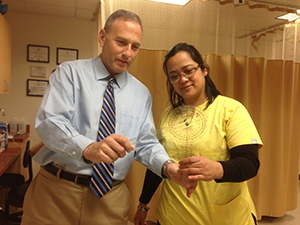Range of Motion
- Posted on: Apr 1 2017
Dr. Jeff J. Mollins, Brooklyn’s premier injury doctor, has been treating patients injured in accidents for almost 30 years. One of the valuable tools utilized by Dr. Mollins when examining and evaluating patients hurt in accidents, is range of motion.
 Range of Motion is the capacity for movement at a given joint in a specific direction. Each joint has a measured (in degrees) normal range of motion. By measuring that specific loss in the range of motion, post accident, Dr. Mollins can determine the level of injury sustained. There are 2 ways to measure range of motion, active and passive. Active range of motion refers to the movement the patient can achieve under their own power. Passive range of motion refers to the movement possible when Dr. Mollins moves the joint for the patient. Dr. Mollins typically uses active range of motion when evaluating injured patients. Dr. Mollins uses a measuring tool called a goniometer to measure range of motion. Let’s say (for example) the injury sustained is in the neck or cervical spine. Dr. Mollins will have the patient move the neck in all 6 directions that are possible within the cervical spine. For example, flexion is when the patient tries to move his/her chin to his/her chest. Dr. Mollins will measure the degrees of which that patient can move until prevented by pain. Normal range of motion in flexion in the cervical spine is 50 degrees. Say the patient can only do it 40 degrees. Thus there is a 10 degree loss in flexion in the cervical spine. Dr. Mollins typically does this measurement (flexion) three times and averages it to insure accuracy. Now Dr. Mollins must perform the same with the other 5 potential ranges of motion of the cervical spine (extension-normal 60 degrees; left lateral flexion-normal 45 degrees; right lateral flexion-normal 45 degrees; left rotation-normal 80 degrees; right rotation-normal 80 degrees). Once completed, Dr. Mollins is able to measure the full loss of motion of the joint (in this case the cervical spine). This same measurement can be applied to any joint in the body.
Range of Motion is the capacity for movement at a given joint in a specific direction. Each joint has a measured (in degrees) normal range of motion. By measuring that specific loss in the range of motion, post accident, Dr. Mollins can determine the level of injury sustained. There are 2 ways to measure range of motion, active and passive. Active range of motion refers to the movement the patient can achieve under their own power. Passive range of motion refers to the movement possible when Dr. Mollins moves the joint for the patient. Dr. Mollins typically uses active range of motion when evaluating injured patients. Dr. Mollins uses a measuring tool called a goniometer to measure range of motion. Let’s say (for example) the injury sustained is in the neck or cervical spine. Dr. Mollins will have the patient move the neck in all 6 directions that are possible within the cervical spine. For example, flexion is when the patient tries to move his/her chin to his/her chest. Dr. Mollins will measure the degrees of which that patient can move until prevented by pain. Normal range of motion in flexion in the cervical spine is 50 degrees. Say the patient can only do it 40 degrees. Thus there is a 10 degree loss in flexion in the cervical spine. Dr. Mollins typically does this measurement (flexion) three times and averages it to insure accuracy. Now Dr. Mollins must perform the same with the other 5 potential ranges of motion of the cervical spine (extension-normal 60 degrees; left lateral flexion-normal 45 degrees; right lateral flexion-normal 45 degrees; left rotation-normal 80 degrees; right rotation-normal 80 degrees). Once completed, Dr. Mollins is able to measure the full loss of motion of the joint (in this case the cervical spine). This same measurement can be applied to any joint in the body.
Conditions affecting Range of Motion – Many factors can affect normal range of motion at a joint. Swelling and inflammation caused by an injury, arthritis, tendinitis, bursitis, or joint infection commonly diminish range of motion. Sprains, strains, bone fractures, muscle weakness and nerve abnormalities can also affect range of motion.
Once a loss in range of motion is established by proper measurement, Dr. Mollins can then place his/her patient on a proper treatment regimen to restore full range of motion. Thus achieve wellness.
Measurement of range of motion is extremely important when treating patients injured in accidents. First of all, it enables Dr. Mollins to determine level of injury (the greater the loss of motion, the greater the injury). Also it enables Dr. Mollins to assess improvement (improvement in range of motions indicates the patient is improving and treatment is helping). In addition, range of motion provides objective documentation (very important when treating injured patients), can be used to assess level of disability and in many cases (if the injury is permanent) can provide an accurate level of permanency.
Posted in: Auto Accident Doctor, Blog, Work Injuries, Workers Compensation



